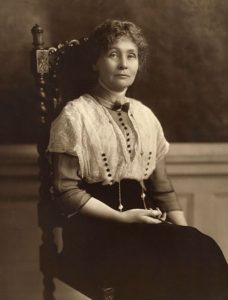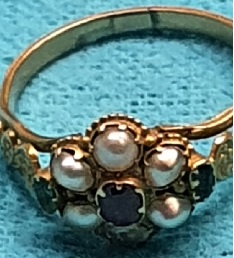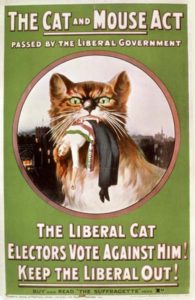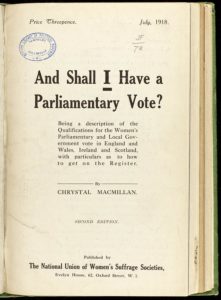
Emmeline Pankhurst (1913) Library of Congress [Public domain]
Hungerford Arcade is full to bursting with antiques and collectables. The one thing that is rarely seen anywhere in the antiques world is Suffragette memorabilia. I think this is mostly because a lot of it is held in museums, handed down the generations in families involved in the movement and people just do not want to part with it.
Well, having said that, stallholder, Ian Spuffard has just acquired a beautiful Suffragette ring. In 1908, the co-editor of the WSPU’s newspaper, Votes for Women, Emmeline Pethick-Lawrence, designed the suffragettes’ colour scheme of purple for loyalty and dignity, white for purity, and green for hope.
Here, you can see those very colours in this stunning ring.

At a political meeting in Manchester in 1905, Christabel Pankhurst and mill worker, Annie Kenney, disrupted speeches by prominent Liberals Winston Churchill and Sir Edward Grey, asking where Churchill and Grey stood with regards to women’s political rights. At a time when political meetings were only attended by men and speakers were expected to be given the courtesy of expounding their views without interruption, the audience were outraged, and when the women unfurled a “Votes for Women” banner they were both arrested for a technical assault on a policeman. When Pankhurst and Kenny appeared in court they both refused to pay the fine imposed, preferring to go to prison in order to gain publicity for their cause.

By Women’s Social and Political Union…NOR. – Museum of London, Public Domain Link
The suffragettes also used other methods to publicise and raise money for the cause and from 1909, the “Pank-A-Squith” board game was sold by the WSPU. The name was derived from Pankhurst and the surname of Prime Minister H. H. Asquith, who was largely hated by the movement. The board game was set out in a spiral, and players were required to lead their suffragette figure from their home to parliament, past the obstacles faced from Prime Minister H. H. Asquith and the Liberal government. Also in 1909, suffragettes Daisy Solomon and Elspeth McClelland tried an innovative method of potentially obtaining a meeting with Asquith by sending themselves by Royal Mail courier post; however, Downing Street did not accept the parcel.
At the commencement of the World War I, the suffragette movement in Britain moved away from suffrage activities and focused on the war effort, and as a result, hunger strikes largely stopped. In August 1914, the British Government released all prisoners who had been incarcerated for suffrage activities on an amnesty, with Pankhurst ending all militant suffrage activities soon after. The suffragettes’ focus on war work turned public opinion in favour of their eventual partial enfranchisement in 1918.
Women eagerly volunteered to take on many traditional male roles – leading to a new view of what women were capable of. The war also caused a split in the British suffragette movement; the mainstream, represented by Emmeline and Christabel Pankhurst’s WSPU calling a ceasefire in their campaign for the duration of the war, while more radical suffragettes, represented by Sylvia Pankhurst’s Women’s Suffrage Federation continued the struggle.

The suffragette campaign was suspended when World War I broke out in 1914. After the war, the Representation of the People Act 1918 gave the vote to women over the age of 30 who met certain property qualifications. Ten years later, women gained electoral equality with men when the Representation of the People (Equal Franchise) Act 1928 gave all women the vote at age 21.
